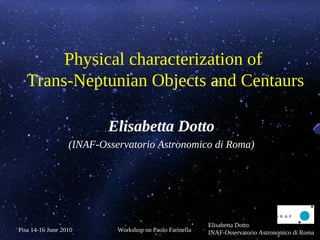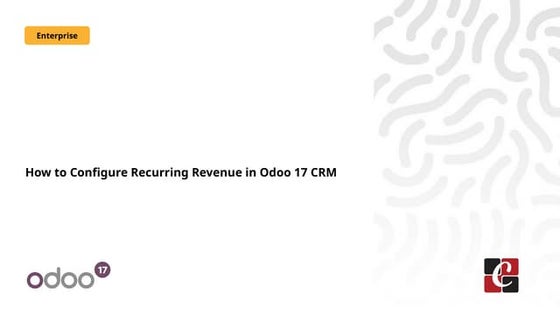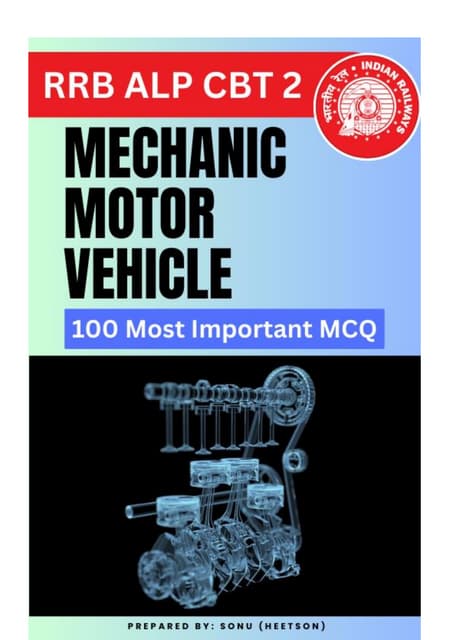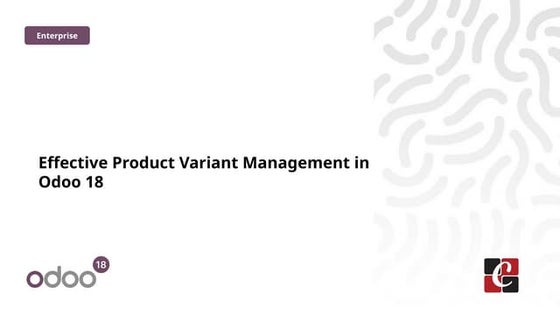N.23 dotto physica-characterization-of-trans-neptunian-objec
- 1. Physical characterization of Trans-Neptunian Objects and Centaurs Elisabetta Dotto (INAF-Osservatorio Astronomico di Roma) Elisabetta Dotto Pisa 14-16 June 2010 Workshop on Paolo Farinella INAF-Osservatorio Astronomico di Roma
- 2. Centaurs and TNOs Elisabetta Dotto Pisa 14-16 June 2010 Workshop on Paolo Farinella INAF-Osservatorio Astronomico di Roma
- 3. Extended scattered disk Sedna: (announced on March 15, 2004) a = 532 AU q = 76 AU Q = 988 AU Elisabetta Dotto Pisa 14-16 June 2010 Workshop on Paolo Farinella INAF-Osservatorio Astronomico di Roma
- 4. Centaurs and TNOs Elisabetta Dotto Pisa 14-16 June 2010 Workshop on Paolo Farinella INAF-Osservatorio Astronomico di Roma
- 5. Centaurs Elisabetta Dotto Pisa 14-16 June 2010 Workshop on Paolo Farinella INAF-Osservatorio Astronomico di Roma
- 6. 30 A.U. < ∆ < ? A.U. ~ 1130 TNOs ~ 161 SDO few 104 with D ≥ 100 km 5 A.U. < ∆ < 30 A.U. 95 Centaurs about 107 D ≥ 1 km Elisabetta Dotto Pisa 14-16 June 2010 Workshop on Paolo Farinella INAF-Osservatorio Astronomico di Roma
- 7. Centaurs and TNOs: light curves & densities • Rotational period, shape, surface structure • Density (with some assumptions...), 9 estimations (45% literature) 06/15/10Antonella Barucci LESIA, Observatoire de Paris
- 8. Centaurs and TNOs: light curves & densities Prot Jacobi ellipsoids Density estimation (Chandrasekhar) (a/bMAX = 2.31) [otherwise unstable to rotation] 06/15/10Antonella Barucci LESIA, Observatoire de Paris Haumea (Illustration: Ann Feild/STScI/ESA/NASA)
- 9. Centaurs and TNOs: light curves & densities ension/density trend? (Sheppard et al. 2008) Pearson correlation coefficient: r = -0.46 Probability of no correlation: ~ 4.8% (with 19 objects) (Perna et al. 2009) Elisabetta Dotto Pisa 14-16 June 2010 Workshop on Paolo Farinella INAF-Osservatorio Astronomico di Roma
- 10. Centaurs and TNOs: light curves & densities ension/density trend? (Sheppard et al. 2008) Pearson correlation coefficient: r = -0.46 -0.29 Probability of no correlation: ~ 4.8% ~ 23% (with 19 objects) (Perna et al. 2009) Elisabetta Dotto Pisa 14-16 June 2010 Workshop on Paolo Farinella INAF-Osservatorio Astronomico di Roma
- 11. Centaurs and TNOs: light curves & densities ension/density trend? (Sheppard et al. 2008) increase the statistics albedo measurements a new model for densities (Perna et al. 2009) Elisabetta Dotto Pisa 14-16 June 2010 Workshop on Paolo Farinella INAF-Osservatorio Astronomico di Roma
- 12. Taxonomical classification G-mode statistical method according to the Barucci et al. (2005) system (Barucci et al. 2010) Elisabetta Dotto Pisa 14-16 June 2010 Workshop on Paolo Farinella INAF-Osservatorio Astronomico di Roma
- 13. s ct je ob al s ic as Cl (Barucci et al. 2010) Elisabetta Dotto Pisa 14-16 June 2010 Workshop on Paolo Farinella INAF-Osservatorio Astronomico di Roma
- 14. Hot and Cold Classicals, True Compositional Diversity? Cold s Hot ct je ob al s ic as Cl •dynamically cold: red colors, low i, small •dynamically hot: diverse colors, moderate and high i, larger sizes (Barucci et al. 2010) Elisabetta Dotto Pisa 14-16 June 2010 Workshop on Paolo Farinella INAF-Osservatorio Astronomico di Roma
- 15. Cold = RR = old Hot = BB = young (Gomes 2003) Elisabetta Dotto Pisa 14-16 June 2010 Workshop on Paolo Farinella INAF-Osservatorio Astronomico di Roma
- 16. Visible Spectra Slope: 1 < S < 51 %/103 Ã… (Fornasier et al. 2009) Elisabetta Dotto Pisa 14-16 June 2010 Workshop on Paolo Farinella INAF-Osservatorio Astronomico di Roma
- 17. Synthetic Spectra Geographical mixtures of : tholins + amorphous carbon (+ water ice + olivine) kerogene + olivine (+ water ice)
- 18. V+NIR spectroscopy • > 50% of objects have H2O ice (amorph+crystalline) • CH4, CH3OH, C2H6 , N2, NH3……………… • aqueous alteration (2003 AZ84, Chariklo and Typhon) • surface heterogeneities Elisabetta Dotto Pisa 14-16 June 2010 Workshop on Paolo Farinella INAF-Osservatorio Astronomico di Roma
- 19. Elisabetta Dotto Pisa 14-16 June 2010 Workshop on Paolo Farinella INAF-Osservatorio Astronomico di Roma
- 20. Featureless spectra Irradiation mantle Elisabetta Dotto Pisa 14-16 June 2010 Workshop on Paolo Farinella INAF-Osservatorio Astronomico di Roma
- 21. Elisabetta Dotto Pisa 14-16 June 2010 Workshop on Paolo Farinella INAF-Osservatorio Astronomico di Roma
- 22. 50000 Quaoar (Dalle Ore et al. 2009)
- 23. 90377 Sedna (2003 VB12) 24% Triton tholin + 7% amorphous carbon + 10% N2 + 26% CH3OH + 33% CH4 (contaminated by small inclusion of Titan tholin) , albedo= 0.15 (Emery et al. 2007) (Barucci et al. 2005) Elisabetta Dotto Pisa 14-16 June 2010 Workshop on Paolo Farinella INAF-Osservatorio Astronomico di Roma
- 24. 90377 Sedna (2003 VB12) VLT-ESO Surface heterogeneity Surface model: H2O+Tritan&Titan Tholins+Serpentine+ CH4+N2+CH3OH (Barucci et al. 2010)
- 25. TNO 55638 and on Centaur Pholus: Methanol (Barucci et al. 2006) Elisabetta Dotto Pisa 14-16 June 2010 Workshop on Paolo Farinella INAF-Osservatorio Astronomico di Roma
- 26. (55638) 2002 VE95 11/2008 18%CH3OH+3%H20+40%TrTh+26%TTh+7%K+6%Ca 12/2007 11% CO3OH+11%H2O+26%TrTh+37%TTh+15%Ca Elisabetta Dotto Pisa 14-16 June 2010 Workshop on Paolo Farinella INAF-Osservatorio Astronomico di Roma
- 27. V+NIR spectroscopy • > 50% of objects have H2O ice (amorph+crystalline) • CH4, CH3OH, C2H6 , N2, NH3……………… • aqueous alteration (2003 AZ84, Chariklo and Typhon) • surface heterogeneities Elisabetta Dotto Pisa 14-16 June 2010 Workshop on Paolo Farinella INAF-Osservatorio Astronomico di Roma
- 28. (Barucci et al. 2010) Elisabetta Dotto Pisa 14-16 June 2010 Workshop on Paolo Farinella INAF-Osservatorio Astronomico di Roma
- 29. Origin of the spectral diversity among TNOs The color of an object depends on its level of resurfacing Formation of an irradiation mantle Resurfacing • Resurfacing vs. Irradiation (Luu & Jewitt, 1996) Red spectra can be flattened by ion irradiation (Moroz et al. 2002; 2003) Elisabetta Dotto Pisa 14-16 June 2010 Workshop on Paolo Farinella INAF-Osservatorio Astronomico di Roma
- 30. Ion Irradiation of an Organic Sampe: ASPHALTITE – natural solid complex hydrocarbon material (solid oil bitumen)  Consists of aliphatic and polyciclic aromatic hydrocarbons (PAHs)  Carbon aromaticity (fraction of aromatic C) is 0.33  H/C ratio is 1.4  Density ~1 g/cm3  Soluble in organic solvents (true bitumen) (Moroz et al. 2002) 4.0 4.0 Asphaltite Dust1 (IN SITU) 3.5 15 + 2 3.5 Asphaltite "Dust" Dust1+7,3x10 H /cm (30 keV) Scaled Reflectance 15 ++ 2 Scaled Reflectance 15 + 2 Asphaltite "Dust" + 0.5x10 Ar /cm 3.0 Dust1+7,3x10 H /cm (30 keV) 15 + 2 + 6,6x10 N /cm (15 keV) 3.0 15 ++ Asphaltite "Dust" + 1.5x10 Ar /cm 2 2.5 15 + Dust1+7,3x10 H /cm (30 keV) 2 16 + 2 2.5 2.0 + 5,9x10 N /cm (15 keV) 2.0 1.5 1.0 1.5 0.5 1.0 0.0 0.5 0.40 0.45 0.50 0.55 0.60 0.65 0.70 0.75 0.80 0.3 0.4 0.5 0.6 0.7 0.8 Wavelength (microns) Wavelength (microns)
- 31. Ratio of icy bodies as a function of their taxonomy • all objects classified as BB were found to have ice on their surfaces • for other taxonomic classes it seems that a ratio of icy and non-icy bodies is approximately the same Elisabetta Dotto Pisa 14-16 June 2010 Workshop on Paolo Farinella INAF-Osservatorio Astronomico di Roma
- 32. Scott Sheppard (2010) in AJ: « The color of extreme outer solar system objects » Inner Oort cloud: (90377) Sedna, 2006 SQ372 & (87269) 2000 OO67 ultra red (S>25) Elisabetta Dotto Pisa 14-16 June 2010 Workshop on Paolo Farinella INAF-Osservatorio Astronomico di Roma
- 33. The reddest objects RR class objects are present in all dynamical populations reddest in Centaurs & detached higher concentration in the classical group (cold=primitive?) ultra red objects in the inner Oort cloud (characteristic of objects kept far from the Sun?) Does red mean « primitive »? Elisabetta Dotto Pisa 14-16 June 2010 Workshop on Paolo Farinella INAF-Osservatorio Astronomico di Roma
- 34. Summarizing: • The wide difference in surface composition and colour could be connected to different original composition and/or different experienced processes. • Collisions must have played a fundamental role on the evolution of TNOs including heating and chemical changes. The consequence of collisions is not only the alteration of the surface properties but also the modification of the internal structure. Collisions are relevant for small and large objects (e.g. Charon-Pluto). Elisabetta Dotto Pisa 14-16 June 2010 Workshop on Paolo Farinella INAF-Osservatorio Astronomico di Roma
- 35. Elisabetta Dotto Pisa 14-16 June 2010 Workshop on Paolo Farinella INAF-Osservatorio Astronomico di Roma







![Centaurs and TNOs: light curves & densities
Prot
Jacobi ellipsoids
Density estimation
(Chandrasekhar)
(a/bMAX = 2.31)
[otherwise unstable to rotation]
06/15/10Antonella Barucci
LESIA, Observatoire de Paris
Haumea (Illustration: Ann Feild/STScI/ESA/NASA)](https://image.slidesharecdn.com/n-23-dottophysica-characterization-of-transneptunian-objec-101005025601-phpapp02/85/N-23-dotto-physica-characterization-of-trans-neptunian-objec-8-320.jpg)










































































